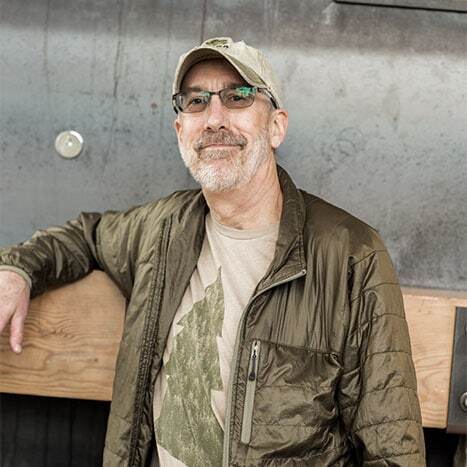Because it has a big effect on both your budget and your pack weight, the backcountry shelter you choose is one of your most important gear-buying decisions. And, to complicate matters, backpacking tents come in an astounding variety of designs, from minimalist to mansion-esque.
To simplify choosing the right backpacking tent, you can break the process down into the following decision points:
- Capacity: likely number of sleepers
- Seasonality: tent construction relative to expected weather conditions
- Weight: ounces carried vs. dollars spent
- Livability: well-placed interior space, ease of access, ease of setup and more
- Setup: features that can make setting up your tent easier
- Materials: what fabrics to consider when shopping for your shelter
For a quick rundown on tents beloved by REI Co-op members, read our roundup of the year's best backpacking tents.
Looking instead for family camping or base camp tents? See our article, Tents for Camping: How to Choose.
Video: How to Choose Backpacking Tents
Backpacking Tent Capacity
Backpacking tents are categorized by capacity: from 1- to 5-person models. Most tent names include a number to denote the capacity: The REI Half Dome 2, for example, fits up to two campers.
To trim weight and bulk, backpacking tent interiors are often compact. There's no industry standard that defines per-person dimensions, so sizes can vary from brand to brand. Ultralight models are likely to be extra tight.
If you're larger or crave more space, consider tents that are designated a person larger than your group. Consider this too if you plan to camp with a pet. Alternatively, you can hunt for a tent that's one or two inches wider or longer than average. Some offer clues in the name, like a plus sign. For example, the REI Co-op Half Dome SL 3+ Tent with Footprint provides enough space for three people, plus gear or a furry friend. Always compare exact dimensions between tents you're considering.
Backpacking Tent Seasonality
Your main choice is between a 3-season and a 4-season tent. Many backpackers, especially newcomers to the backcountry, will choose a three-season tent because it provides enough protection from wind, rain and bugs without weighing down your pack (backcountry shelters meant to withstand extreme weather are often heavier). But because worst-case weather scenarios won't be the same for every trip, frequent backpackers sometimes choose to own more than one tent. Generally, 3-season tents are great for trips in the summer, spring and early fall, while 4-season tents are good for trips where you expect extreme weather conditions, like heavy snowfall or powerful winds (more below).
3-Season Backpacking Tents
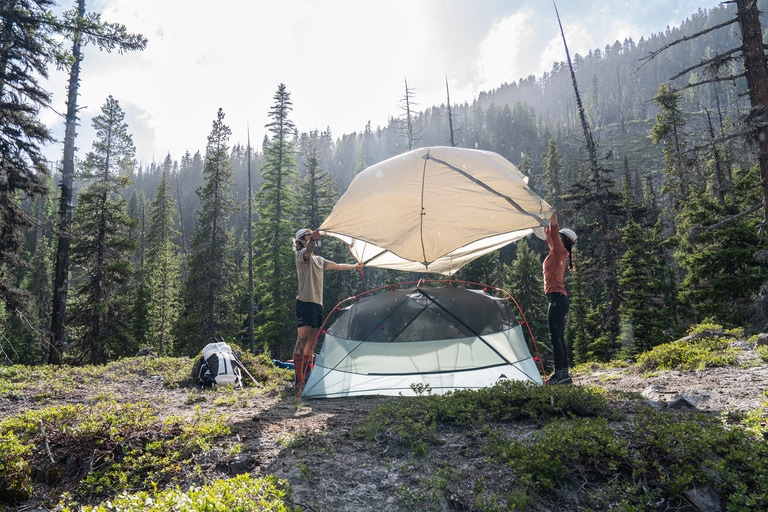
These tents balance the need to keep weight low with the need to handle the wide range of conditions that spring, summer and fall can conjure up. Properly pitched, 3-season tents can withstand downpours and light snow but are not built for sustained exposure to harsh storms, violent winds or heavy snow. Key features:
- Ample mesh panels to boost airflow and keep out insects
- More upright walls to create more interior headroom
- Fewer poles and lighter fabrics to keep weight low
Shop 3-Season Backpacking Tents
Extended-Season Backpacking Tents (3-4 or 3+ Season)
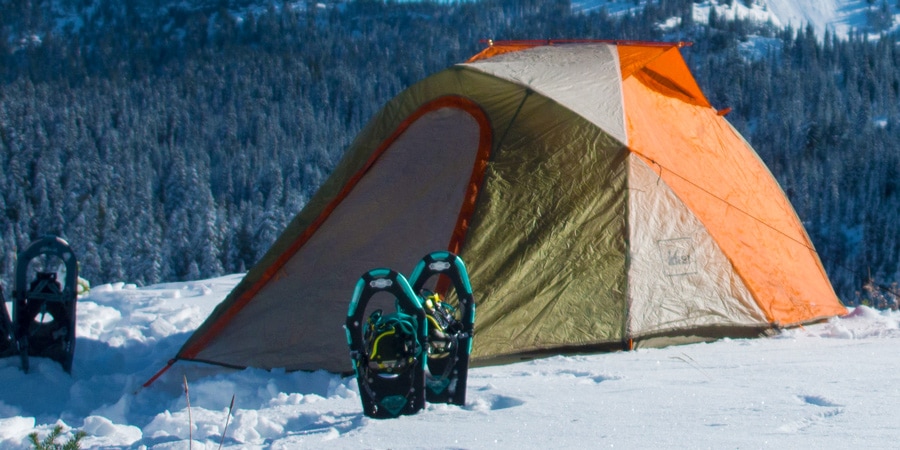
These tweener tents are suitable for summer use but also trips in early spring and late fall when snow may be encountered. They're also good for trips to exposed, high-elevation destinations where snow can surprise you. Key features (compared to pure 3-season models):
- Fabric panels that can zip over mesh areas to keep out blowing snow, and hold in more warmth
- One or two more poles (than a 3-season tent) for additional strength
Shop Extended Season Backpacking Tents
4-Season Mountaineering Tents
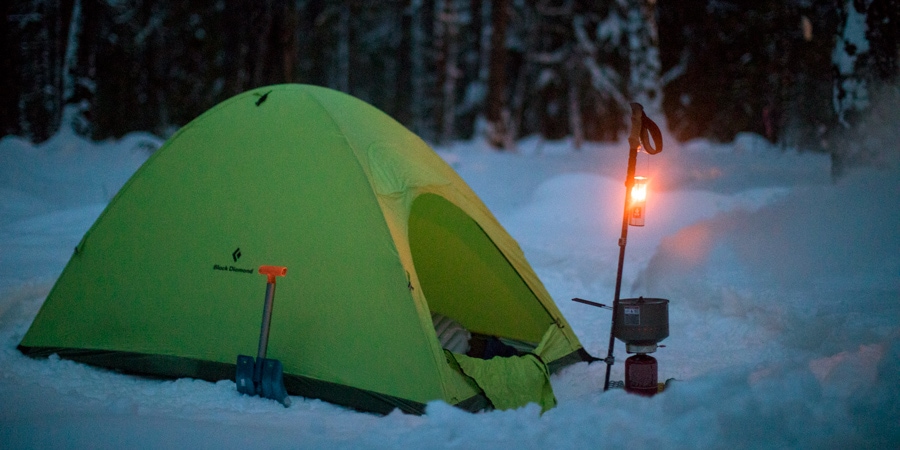
These winter tents are engineered to withstand fierce winds and substantial snow loads; however, they have less ventilation and can feel stuffy in mild weather. Key features (compared to 3-season and extended-season models):
- More poles and more heavy-duty fabrics
- Rounded dome designs that can sustain winds and eliminate flat roof spaces where snow can collect
- Fewer mesh panels; or they might have zip fabric panels that let you cover the mesh panels when needed
- Rainflys that extend close to the ground
Four-season tents also include lightweight single-wall tents that have waterproof/breathable walls and no rainfly. In humid conditions condensation can accumulate inside, so a single-wall tent is best for cold, dry conditions. (For tips on dealing with a humid tent interior, read How to Prevent Condensation in a Tent.)
Shop 4-Season Mountaineering Tents
Backpacking Tent Weight
The weight of your backpacking tent is a big part of your overall load, so tent designers work hard to keep it low. Your biggest tradeoffs to cutting weight are space, features and durability. If you choose carefully, though, you should be able to find a lightweight tent that feels reasonably roomy and comfortable to you.
While heavy-duty materials make a tent more durable, ultralight tents can be surprisingly sturdy. If you want a premium ultralight tent, you'll pay more for ultralight-yet-strong materials. Also, the term "ultralight" is used liberally by brands—check specs carefully when you shop.
Key Tent Specs
- Minimum trail weight: This is the weight of the tent body, rainfly and poles only. You will probably pack more tent-related gear (e.g., tent stakes, a footprint), but this is the best spec for comparison. (Note that some ultralight shelters are designed to function without the need for a separate rainfly or tent poles, so their minimum trail weights will reflect only the essential components that come with those tents.)
- Packaged weight: This is the weight of all the components you get with a purchase: body, rainfly, poles, stakes, stuff sack, pole sack, instructions and more. Because you likely won't bring every item on your trips (for instance, you likely won't need to bring every stake that comes with your tent), the weight you'll carry on the trail will be somewhere between this and the minimum weight.
- Packed size: The amount of space the tent takes up in a pack also relates to how easy a tent is to carry. You can reduce this space by splitting up components—have your partner take the poles and rainfly, for example, while you carry the tent body. You can also save a few extra ounces when you do this by leaving the tent storage bag at home.
Minimalist Shelters
Most backpacking tents have a double-wall design that includes a main tent body (also known as the canopy) plus an exterior rainfly. If you're a hiker who focuses on saving every possible ounce, you have additional options.

Fly/footprint option: Many double-wall tents have an ultralight setup option, where the footprint (sold separately), poles and rainfly can be pitched together without the main tent canopy.
Tarp shelters: This catchall category includes ultralight rainflys that shield you from rain and snow, but not bugs or damp ground.
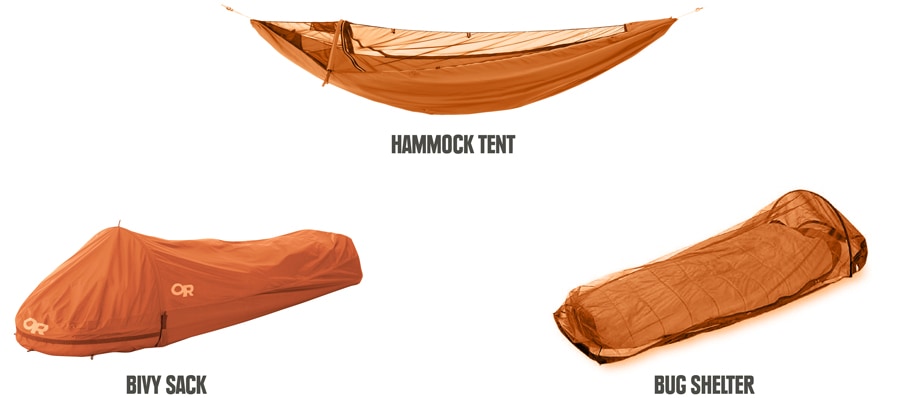
Hammock tents: This is a type of hammock that, at a minimum, also includes a tarp-like rainfly and bug netting.
Bivy sacks: Short for bivouac sack, this is a waterproof, breathable barrier for your sleeping bag.
Bug shelters: Most bug shelters consist of netting and some poles, but no floor. More elaborate models are tents where the entire canopy is made out of bug netting.
Backpacking Tent Livability
"Livability" is a catchall word for features that make the time you spend inside your tent more enjoyable. A big part of livability is how roomy—or cramped—a tent feels to you. Backpacking tents have traditionally had steeply sloped walls, minimal floor space and hardly any headroom to keep the weight low. However, that came at the expense of comfort. Thanks to advances in materials and designs that can help minimize weight, tent options today can offer a little more room. Below are a few specs to consider when assessing a shelter's livability.
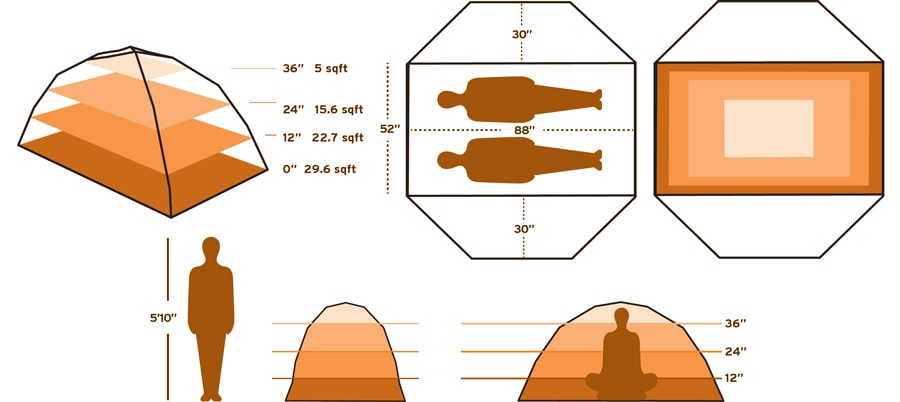
Floor dimensions (floor plan): Length and width measurements offer a rough idea of floor size. Many tents don't have perfectly rectangular floors, so you might see dimensions like 85" x 51"/43" (L x W head/foot). A tapered floor provides needed room for shoulders and arms, while also saving weight by having a narrower foot.
Floor area: This number indicates total square footage of floor-level space. While helpful for comparison between tents, this number alone won't tell you how efficiently the space is laid out.
Peak height: No one likes to bump their head when they sit up. Peak height, though, is measured at a single spot, so don't rely solely on this spec to assess overall headroom. The test pitch (noted above) is much better way to assess that.
Wall shape: This is an even bigger factor in head and shoulder room—and overall tent livability—than peak height. The more vertical the walls, the more open the tent's interior will feel. Study the pitch of a tent's walls in online photos: If they angle steeply toward the tent's ceiling, you're looking at a more weight-efficient tent (great!) that offers only modest interior volume (the tradeoff).
Test-pitch tents: Visit a store and ask to set up prospective tents so you can hop inside them. Then make your mountain-storm pick: Which model would you choose if you had to ride out a storm for hours on end?
Additional Features that Improve Tent Livability
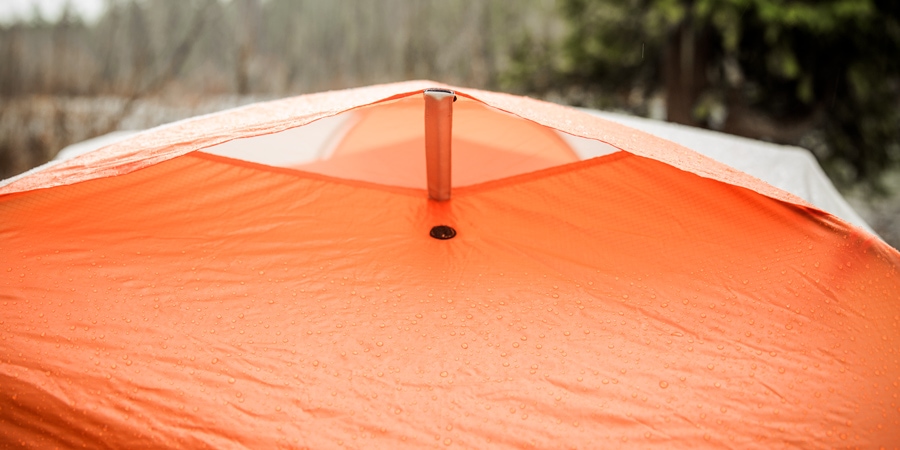
Rainfly color: Light, bright fly colors transmit more light inside, making the interior brighter. That will make a tent feel more spacious and make it a more pleasant place to be if a storm keeps you tentbound for an extended time. It also makes your tent easier to spot.
Doors: Tent designers focus on door shape, zippers and other adjustments, but the most important question is: How many? It's nice when every sleeper has a door. Choosing a multiperson tent with a single door, though, cuts weight and cost.
Vestibules. These rainfly extensions offer sheltered storage for boots and other gear. An oversized floor area would offer the same advantage, but it would also create a heavier tent. Most tents have vestibules and their size is included in the specs. Bigger is better, but cavernous vestibules can add weight and cost.
Ventilation: You exhale moisture as you sleep and a tent needs ways to deal with that. That's why features like mesh windows or panels and adjustable rainfly vents are important: They let you increase airflow to prevent condensation buildup inside. Being able to roll up rainfly doors or panels can also boost ventilation. As a bonus, it also lets you open up views to gaze at stars or witness the sunrise.
Storage: Don't underestimate the power of interior mesh pockets. They're helpful for keeping essential items within easy reach, which can be especially helpful when you're searching for gear after dark. You can even slip a lantern or headlamp into an overhead pocket to illuminate your space.
Tent Setup
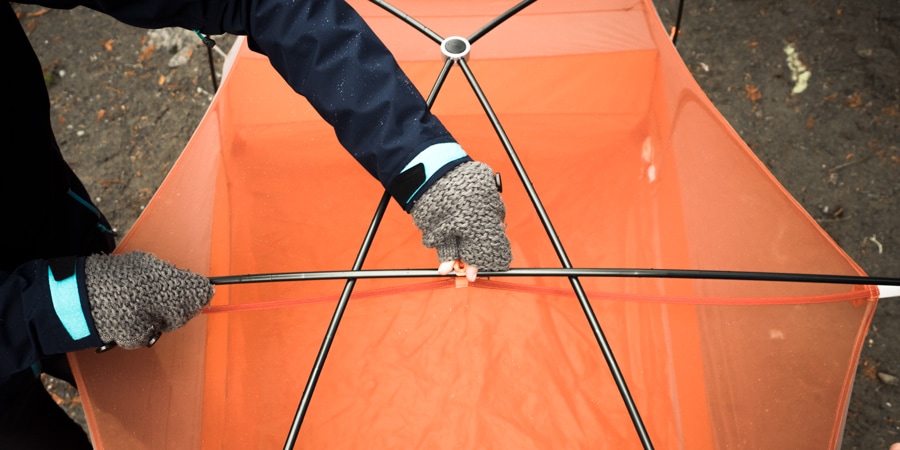
It's always wise to set up a tent once or twice before trying to do it in the wilderness. Regardless of where you pitch it, the following features can make setup easier:
Freestanding design: This simply means the tent can stand without the use of stakes, which speeds setup and makes a tent easy to reposition—just lift and move it to a new spot. Most tents are freestanding for this reason, though non-freestanding tents can be lighter because the pole structure doesn't have to be as robust.
Pole hubs: The beauty of hubs is that they take the guesswork out of assembly. You take the folded pole sections out of the duffel bag and unfurl the skeleton, seating segments as you go. Smaller cross poles might be separate from the hub, but those are easily identified after the main pole assembly is complete. The other major benefit of hubs is that they allow tent walls to be more vertical to create a more livable interior space.
Pole clips: Poles connect to tent canopies via clips, sleeves or a combination of the two. Pole sleeves' fabric tension provides a stronger pitch, but threading poles through them can be a challenge. Pole clips are lighter and easier to attach. They also allow more airflow underneath the rainfly, which reduces condensation.
Color coding: This helps you quickly orient each pole tip to the correct tent corner and helps you find which sleeves or clips go with which pole sections.
For setup tips that apply to any tent, read How to Set Up a Tent.
Tent Materials
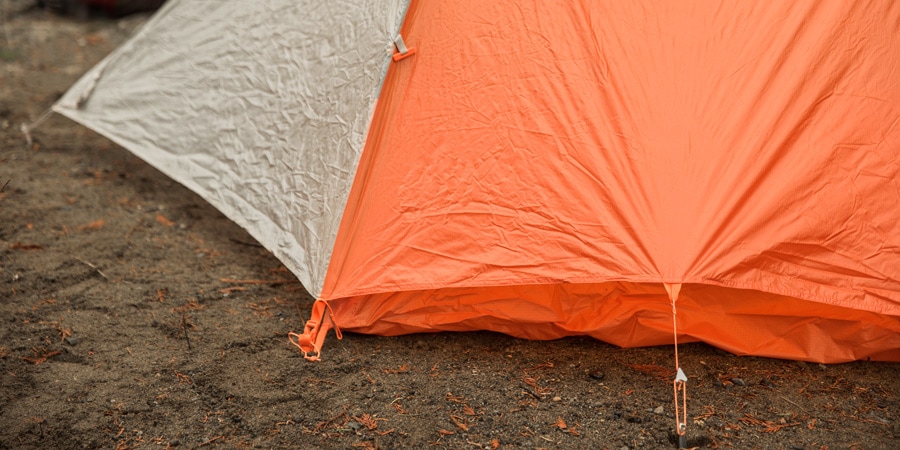
Poles: Backpacking tents have high-strength, low-weight aluminum poles. You often see DAC (Dongah Aluminum Corp.) in specs because this company is the world's pre-eminent pole maker.
Tent fabrics and denier: A wide range of specialized nylons and polyesters are used in tents. One spec you occasionally see is denier (D), which is a fabric yarn's weight (in grams) based on a 9,000-meter length of the yarn. More rugged fabrics have higher denier numbers, while lower deniers are found in more lightweight—and less durable—fabrics. Don't compare denier unless fabrics are identical, though, because inherent differences in fabric properties have a greater effect on strength than the denier spec.
Tent strength. The strongest tents have strong poles and fabrics, and combine them in sturdy design architectures. The only spec that relates to strength, though, is a tent's seasonal rating—a 4-season tent will be stronger than a 3-season tent.

